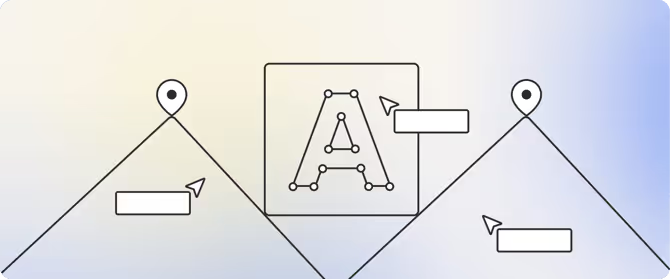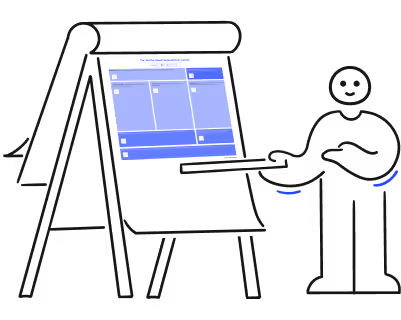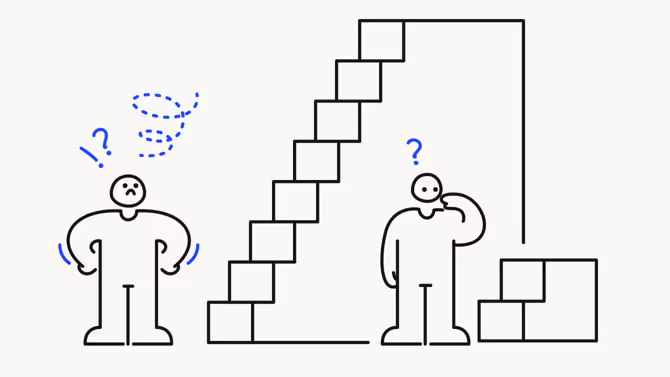Introducing the skills-based canvas: What is it and how to use it

Empower your organization with the skills-based canvas.

Today's organizations face the growing challenge of effectively managing and developing their workforce's skills. To meet this demand, a skills-based approach has emerged as a powerful strategy to align employee capabilities with organizational goals. At the heart of this approach lies the skills-based canvas, a structured framework designed to support skill management and drive talent development.
In this article, we will explore the various facets of the skills-based canvas, its key components, and the remarkable benefits it offers to organizations seeking to enhance their workforce's skills.
Understanding the skills-based canvas
To build a strong foundation, let's delve into the concept of a skills-based approach and its crucial role in talent development. The skills-based canvas serves as a structured and comprehensive framework, enabling organizations to identify, assess, and develop their employees' skills effectively. By adopting this approach, organizations gain a deeper understanding of their workforce's capabilities, allowing them to align talent with strategic objectives and adapt to changing market demands.
Benefits of the skills-based canvas
Comprehensive skill management: Gain a holistic view of employees' skills and competencies, aligning them with strategic goals to drive organizational success.
Targeted skill development: Identify skill gaps within the workforce and implement targeted training initiatives to bridge these gaps effectively.
Cultivate a learning culture: Empower employees to take ownership of their skill development, fostering a culture of continuous learning and growth.
Enhanced workforce efficiency: Streamline talent management processes, from recruitment to performance evaluation, for increased efficiency and productivity.
Improved employee engagement: Engage and motivate employees by providing opportunities for skill development and growth, leading to improved retention rates.
Adaptability and agility: Equip the workforce with the necessary skills to adapt to changing market demands and maintain a competitive edge.
Strategic talent development: Utilize the skills-based canvas as a strategic tool to unlock the full potential of the workforce and achieve long-term organizational success.
How to use the Skills-Based Canvas
The skills-based canvas consists of key components that work in harmony to support skill management. From defining skill categories to conducting skill assessments and creating personalized development plans, each element contributes to a holistic approach to talent development.
Here are the 7 key components of the Skills-Based Canvas Framework.
1. Identify the key organizational objectives:
- What are your business and organizational objectives? What are the next organizational priorities?
Examples: increase talent retention, increase internal mobility, improve organization agility
{emphasize}
Protip: Linking your HR initiatives to the business strategy is crucial for stakeholder buy-in and creating the wanted value for the organization. Understanding the organization's vision and objectives is crucial for HR to become a strategic partner.
{emphasize}
2. Identify key stakeholders:
- Who are the key stakeholders or managers within your organization in each critical function who hold valuable insights to guide you towards success? How can their domain expertise be leveraged to identify skill gaps?
{emphasize}
Protip: Foster collaboration with these stakeholders, tapping into their knowledge and expertise to enhance the identification of the required skills in the organization to achieve business objectives and the skills present in the organization, to identify the gaps.
{emphasize}
3. Identify top skills
- What are the critical skills required to achieve your business objectives? Can you identify these top skills with the help of each function stakeholder? How can you strategically align your talent development efforts with these critical areas for success?
{emphasize}
Protip: As an HR professional, you can conduct research and stay in tune with your industry through trend monitoring, professional networks, and engaging discussions. This will help you identify some of the most sought-after skills in the market, both now and in the future. Discuss with your stakeholders to see if these skills could be added to the necessary skills to achieve business objectives.
{emphasize}
4. Assess skill gaps:
- What skills currently exist within your organization? Can you identify these with the help of each function stakeholder? How do these skills compare to what is required, highlighting any gaps? What insights can this evaluation offer to deepen your understanding of your workforce's capabilities and pinpoint areas for development?
{emphasize}
Protip: AI tools are now available that make skills mapping and generating comprehensive skills gap reports quick and effortless, requiring just a few minutes of your time. The best part is that some of these tools are completely free. By utilizing these tools, you can gain valuable insights into your workforce's capabilities and identify specific areas for development.
{emphasize}
5. Develop an HR strategic plan:
How can you bridge the identified skill gaps within your organization? Here are the various strategies to consider:
- Update your Talent Acquisition Plan: Evaluate the need to hire external talent or engage outside contractors, considering time, budget, and candidate availability.
- Rethink upskilling & reskilling: Explore opportunities to train and develop existing employees, equipping them with the necessary skills. Consider feasibility within your desired timeframe and budgetary constraints.
- Address organization-wide learning needs with learning programs: Develop targeted learning programs to enhance essential skills for the modern work environment. Prioritize skills like resilience and innovation that are relevant across teams and throughout the organization. Equipping employees with comprehensive training in these areas empowers them to excel in a fast-paced and ever-changing workplace.
{emphasize}
Protip: Customize your approach for each situation, be it talent acquisition, upskilling, or reskilling, to address skill gaps in your organization. Choose suitable strategies and utilize tools to create targeted employee development plans that address identified gaps. This ensures effective and focused efforts in closing skill gaps and fostering continuous growth in your workforce.
{emphasize}
6. Find your collaborators:
- Who are the mentors and subject matter experts who can contribute valuable guidance and support in executing your strategic plan? Who are the individuals within your organization with the expertise and willingness to facilitate skill development and foster a culture of continuous learning?
{emphasize}
Protip: Perfect your talent development efforts by defining SMART KPIs that are specific, measurable, attainable, relevant, and time-bound. Regularly track and analyze these metrics to gain valuable insights and drive long-term organizational growth. By continuously watching and evaluating the effectiveness of your talent development initiatives, you can make data-driven decisions and enhance your organization's overall performance.
{emphasize}
7. Measure and track success:
- How can you effectively measure and track the success of your talent development initiatives? What key performance indicators (KPIs) should be defined and aligned with your objectives?
Examples: NPS score, retention rate, etc.
{emphasize}
Protip: Perfect your talent development efforts by defining SMART KPIs that are specific, measurable, attainable, relevant, and time-bound. Regularly track and analyze these metrics to gain valuable insights and drive long-term organizational growth. By continuously watching and evaluating the effectiveness of your talent development initiatives, you can make data-driven decisions and enhance your organization's overall performance.
{emphasize}
Moving forward
The skills-based canvas serves as a potent tool for organizations seeking to optimize talent development and drive workforce success. By adopting this structured approach, you can unlock the full potential of your workforce, aligning skills with strategic goals and embracing adaptability. We encourage organizations to embrace the skills-based canvas as a pivotal element in their talent development journey.
Starting with guidance and real-life examples can make the process easier, and we have great news! We are organizing a workshop on September 8 to help you unleash the full potential of the skills-based canvas. Reserve your seat now - it's free!
Reserve your seat for the workshop today.
Monitor, support, and optimize your team's professional development.


%20(1).avif)


.avif)
.avif)








